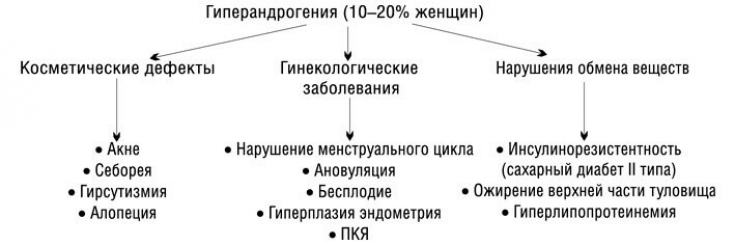At the present stage, it is proposed to distinguish three subtypes of acne in women, depending on the onset of the disease, in particular:
- persistent subtype (clinical manifestations begin in adolescence and progress into adulthood),
- late / acne tarde (clinical manifestations first appear after the age of 25),
- relapsing (clinical manifestations begin in adolescence, then cease and recover in adulthood).
In each of these types of acne, the leading role is played by the endocrine status of the patient.
Find out in the article on estet-portal.com about the clinical manifestations and symptoms that are encountered in the practice of a dermatologist, as well as modern approaches to the treatment of this pathology.
- Classification of acne severity
- Modern approaches to the treatment of acne
- Hyperandrogenism and dermatological diseases
- Results of acne treatment in hyperandrogenismand
Acne Severity Classification
Severity of the clinical course of acne in women is determined in accordance with the classification proposed by Plewig & Kligman (2004) with subsequent modification by Russian Society of Dermatovenerologists (2010).
Follow us on Instagram!
According to the calculation of the number of elements and the nature of the rash, four degrees of severity of acne are distinguished:
- The first degree of the severity of acne is characterized by the appearance of closed and open comedones on the skin without inflammatory manifestations (non-inflammatory form of the lesion).
- The second degree of severity is characterized by the presence of comedones, papules and rare pustules, which are accompanied by inflammatory manifestations.
- The third degree of acne severity is characterized by the appearance of comedones, papules, pustules and solitary cysts, as well as expressive inflammatory manifestations in the areas of skin lesions.
- The fourth degree of the severity of acne combines all the above elements of the rash, including numerous nodes and cysts, which are accompanied by an inflammatory reactionth.
Three pillars of modern topical acne management
Modern approaches to acne treatment
Acne treatment aims to eliminate:
- abnormal keratinization in the ducts of the sebaceous glands;
- hyperseborrhea;
- microflora activity in the sebaceous glands;
- inflammation.
The choice of the proposed treatment regimens for acne depends on the severity of the dermatosis.
At the same time, today, the question of the role of hormonal disorders in the development of acne remains insufficiently studied, insufficient attention is paid to the diagnostic criteria of the hormonal status of the organism in women with acne, and differentiated therapy has not been developed depending on hormonal disordersth.

Hyperandrogenism and dermatological diseases
Manifestation of hyperandrogenism syndrome during visual examination of patients is observed only in half of women with laboratory-confirmed hormonal disorders that form a state of hyperandrogenism.
It can be assumed that the pronounced clinical manifestations of hyperandrogenism syndrome are diagnosed in a more distant period from the onset of changes in the hormonal status of a woman.
Testosterone and acne: how to break the vicious cycle
Markers of adrenal hyperandrogenism are considered to be increased:
- 17-OH-progesterone;
- DHEA-s;
- testosterone.
The reason for mixed hyperandrogenism is:
- increase in plasma prolactin content;
- increase in the amount of free testosterone in the blood plasma.
Hyperandrogenism in women may be due to hyperprolactinemia syndrome.
Due to an increase in the level of prolactin in the blood plasma, pathological changes are possible, for example: an increase in the production of squalene (a precursor of cholesterol in the sebaceous glands), an increase in the content of dehydroepiandrosterone sulfate, which causes hypertrichosis.
Since prolactin has a direct or indirect metabolic effect on all tissues of the human body, even a slight increase in its content in blood plasma can cause hyperandrogenism.
Thus, hyperandrogenism produces a stimulating effect on the sebaceous glands, increasing the volume of sebum.
Results of acne treatment with hyperandrogenism
The results of the observation of women with acne, against the background of the established syndrome of hyperandrogenism, after a 6-month course of complex differentiated antiandrogen therapy indicated the absence of a clinical recurrence of acne during the year of observation.

A month from the start of treatment, a slight increase in the number of inflammatory elements of acne was recorded, which indicated an exacerbation of the disease.
After 4 months after the start of treatment, all women showed a significant reduction in the number of inflammatory elements of acne, both superficial and deep, regression of comedones and shallow inflammatory elements, papulo-pustules.
After 6 months of treatment, complete regression of elements of acne was recorded in 41.2% of women, and significant clinical improvement was achieved in 58.8% of patients.
4 main methods of systemic acne therapy
Thus, the use of differentiated systemic antiandrogen therapy in women who suffer from acne, taking into account the type of hyperandrogenism (adrenal, ovarian, mixed) is pathogenetically substantiated, which allows to increase the effectiveness treatment and prevents the occurrence of recurrences of dermatosis.









Add a comment